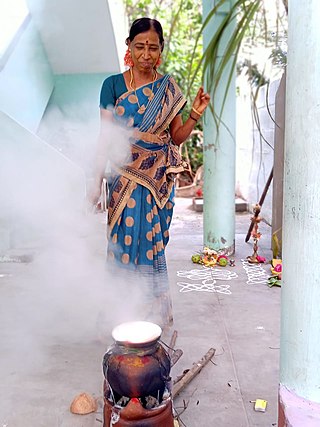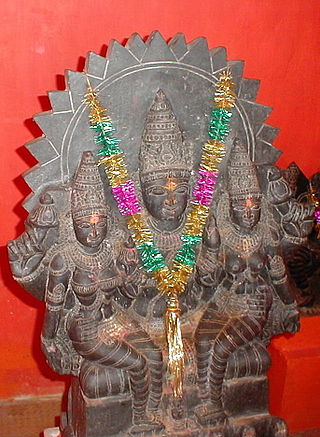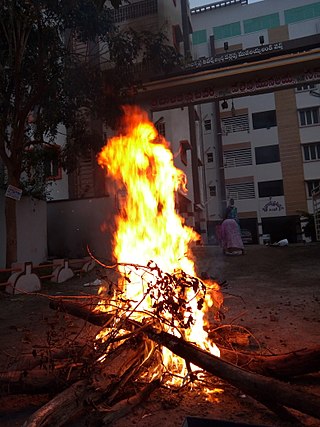
Pongal, also referred to as Thai Pongal, is a multi-day Hindu harvest festival celebrated by Tamils. It is observed in the month of Thai according to the Tamil solar calendar and usually falls on 14 or 15 January. It is dedicated to Surya and corresponds to Makar Sankranti, the Hindu observance celebrated under many regional names throughout the Indian subcontinent. The festival is celebrated over three or four days with Bhogi, Surya Pongal, Mattu Pongal and Kanum Pongal, observed on consecutive days.

Makar(a) Sankranti, also referred to as Uttarayana, Makar, or simply Sankranti, is a Hindu observance and a festival. Usually falling on the date of 14 January annually, this occasion marks the transition of the sun from the zodiac of Sagittarius (dhanu) to Capricorn (makara). Since the sun has made this transition which vaguely coincides with moving from south to north, the festival is dedicated to the solar deity, Surya, and is observed to mark a new beginning. Many native multi-day festivals are organised on this occasion all over India.

Rangoli is an art form that originates from the Indian subcontinent, in which patterns are created on the floor or a tabletop using materials such as powdered lime stone, red ochre, dry rice flour, coloured sand, quartz powder, flower petals, and coloured rocks. It is an everyday practice in many Hindu households, however making it is mostly reserved for festivals and other important celebrations as it is time-consuming. Rangolis are usually made during Diwali or Tihar, Onam, Pongal, and other Hindu festivals in the Indian subcontinent, and are most often made during Diwali. Designs are passed from one generation to the next, keeping both the art form and the tradition alive.
Sankranti refers to the transmigration of the sun from one zodiac to another in Indian astronomy. In Saurmanavarsha, there are twelve Sankrantis corresponding with twelve months of a year. The Sankrantis can be broadly classified into four main categories: Ayan (Solstice), Vishuva (Equinox), Vishnupadi and Shadshitimukhi sankrantis.

Jallikattu, also known as Eru Taḻuvuṭal and Manju-virattu, is a traditional event in which a zebu bull, such as the Pulikulam or Kangayam breeds, is released into a crowd of people, and many human participants attempt to grab the large hump on the bull's back with both arms and hang on to it while the bull attempts to escape. Participants hold the hump for as long as possible, attempting to bring the bull to a stop. In some cases, participants must ride long enough to remove flags on the bull's horns.

Bull-leaping is a term for various types of non-violent bull fighting. Some are based on an ancient ritual from the Minoan civilization involving an acrobat leaping over the back of a charging bull. As a sport it survives in modern France, usually with cows rather than bulls, as course landaise; in Spain, with bulls, as recortes and in Tamil Nadu, India with bulls as Jallikattu.

Kolam, also known as Muggu, Tarai Alangaram and Rangoli is a form of traditional decorative art that is drawn by using rice flour as per age-old conventions. It is also drawn using white stone powder, chalk or chalk powder, often along with natural or synthetic color powders. Its origin belongs to the ancient Tamil Nadu known as Tamilakam and has since spread to the other southern Indian states of Karnataka, Telangana, Andhra Pradesh, and Kerala. It can be found in some parts of Goa and Maharashtra. Since the Tamil diaspora is worldwide, the practice of kolam is found around the world, including in Sri Lanka, Singapore, Malaysia, Indonesia, Thailand and a few other Asian countries. A kolam or muggu is a geometrical line drawing composed of straight lines, curves and loops, drawn around a grid pattern of dots. It is widely practised by female family members in front of their house entrance, although men and boys also practice this tradition. The similar regional versions of kolam with their own distinctive forms are known by different names in India: raangolee in Maharashtra, aripan in Mithila, alpona in West Bengal and hase and rangole in Kannada in Karnataka. More complex kolams are drawn and colors are often added during festival days, holiday occasions and special events.
The term Uttarāyaṇa is derived from two different Sanskrit words – "uttaram" (North) and "ayanam" (movement) – thus indicating the northward movement of the Sun. In the Gregorian calendar, this pertains to the "actual movement of the sun with respect to the earth." Also known as the six month period that occurs between the winter solstice and summer solstice. According to the Indian solar calendar, it refers to the movement of the Sun through the zodiac. This difference is because the solstices continually precess at a rate of 50 arcseconds per year due to the precession of the equinoxes, i.e. this difference is the difference between the sidereal and tropical zodiacs. The Surya Siddhanta bridges this difference by juxtaposing the four solstitial and equinoctial points with four of the twelve boundaries of the rashis.

Ratha Saptami, also rendered Magha Saptami, is a Hindu festival that falls on the seventh day (saptami) in the bright half of the Hindu month Magha. It is symbolically represented in the form of the sun-god Surya turning his ratha (chariot) drawn by seven horses towards the northern hemisphere, in a north-easternly direction. It also marks the birth of Surya and is hence also celebrated as Surya Jayanti.
Keelakolathur is a village in the Ariyalur taluk of Ariyalur district, Tamil Nadu, India.
Kondayampalli is a Grem panchayat in Gangavalli taluk, Salem district, Tamil Nadu State, India.
Periya Ilanthai Kulam is a village located in the Madurai district of Tamil Nadu, India. It is situated on the slopes of Vaguthu Malai.

The Kangayam or Kangeyam is an Indian breed of draught cattle from the state of Tamil Nadu, in South India. Its area of origin is Kongu Nadu, the region surrounding Coimbatore, close to the border between Tamil Nadu and Kerala, but it is distributed over a considerably wider area. The breed name derives from that of the town of Kangeyam. It may also be called Kanganad or Kongu.
Here is a list of glossary of culture of India in alphabetical order:
Many sports are originated from Tamil Nadu played people from Tamil Nadu including both traditional sports and sports from other countries. Also Tamil Nadu is emerging as the Sports Capital State of Indian Subcontinent.

Bhogi is the first day of the four-day Pongal festival. It falls on last day of Agrahāyaṇa or Mārgaśīrṣa month of Hindu Solar Calendar, which is 13 January by the Gregorian calendar. It is the day before Makar Sankranti, celebrated widely in Andhra Pradesh, Telangana, Karnataka, Tamil Nadu, and Maharashtra.

Mampatti is a village in Singampunari Taluk in Sivagangai District of Tamil Nadu State, India. It comes under Mampatti South panchayath union. It is a constituent of the ancient "Mallakottai Nadu" once, which was a part of 'Sivagangai Seemai'. For administrative purpose, the whole Mampatti region was divided into three Revenue Villages namely South Mampatti, North Mampatti and Mampatti Devasthanam, each under the authority of a Village Administrative Officer. Mampatti Devasthanam is the region that covers the land of temples that belongs to Sivagangai Samasthanam Devasthanam.

The 2017 pro-jallikattu protests, also known as the pro-jallikattu movement, were leaderless apolitical youth protests which took place in January 2017 in large groups in several locations across the Indian state of Tamil Nadu. Some sporadic smaller protests also took place across India as well as overseas. The chief motivation of the protest was against the Supreme Court's order to ban jallikattu, a traditional Tamil bull taming sport, which is held during Pongal, a harvest festival in the state of Tamil Nadu, India. The sport is conducted annually on the second day of the Tamil month Thai. The sport was banned by the Supreme Court in a decision citing cruelty to animals based on a lawsuit filed by the animal rights group People for the Ethical Treatment of Animals (PETA), which asserted that it violates the Prevention of Cruelty to Animals Act (PCA).
Kaanum Pongal or Kanum Pongal is the fourth and the final day of the four-day Pongal festival. According to the Gregorian calendar it is celebrated on 17 January. Though the name of the festival is specific to Tamil Nadu, it is also celebrated in other southern Indian states such as Andhra Pradesh and Karnataka as the festival is significantly popular in South India. The day of Kaanum Pongal is often acknowledged as the Thiruvalluvar Day in remembrance of the great historic Tamil writer, poet and philosopher Thiruvalluvar who was known for writing the world famous Thirukural. The day is also popularly treated as the sightseeing day as well as the Thanksgiving day. People believe Kaanum Pongal is an auspicious day to arrange marriage proposals and to kick start new bonds and relationships.

Rice has religious significance and spiritual heritage in India, and is considered a sacred grain in Hindu scriptures such as the Vedas, Taittirīya Brāhmaṇa, Shatapatha Brahmana, the Mahabharata epic, and in archaeological finds in places such as the holy city of Kashi.














